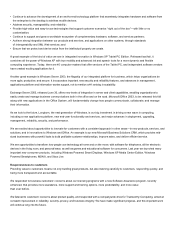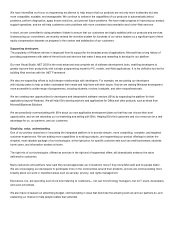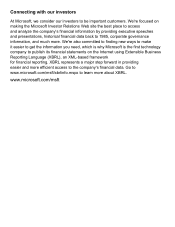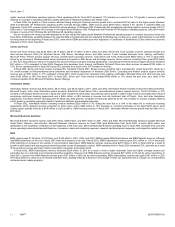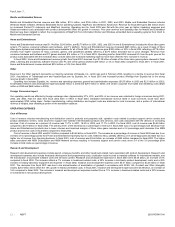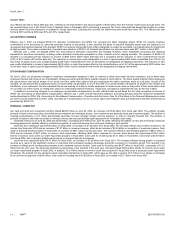Microsoft 2003 Annual Report Download - page 18
Download and view the complete annual report
Please find page 18 of the 2003 Microsoft annual report below. You can navigate through the pages in the report by either clicking on the pages listed below, or by using the keyword search tool below to find specific information within the annual report. MSFT 2003 FORM 10-K
5 /
Part I, Item 1
Enterprise Subscription Agreement. The Enterprise Subscription Agreement (ESA) is a time-based, multi-year licensing arrangement. Under an ESA,
customers acquire the right to use the current version of software products and the future versions that are released during the three year term of the
arrangement. At the end of the arrangement term, customers may either renew their ESA arrangement or exercise a buy-out option to obtain perpetual
licenses for the latest version of the covered products. If they do not elect one of these options, then all covered software must be uninstalled.
Online Services and Products
We distribute online content and services through MSN Subscription services, MSN Network services, bCentral small business portal, and other online services.
MSN Subscription services deliver Internet access and other premium services and tools to consumers. MSN Network services deliver online email and
messaging communication services as well as information services such as online search and premium content. The bCentral portal provides tools and expertise
for small business owners to build, market and manage their businesses online. Other services delivered online include Microsoft Developer Networks (MSDN)
subscription content and updates, periodic product updates, and online technical and practice readiness resources to support our partners in developing and
selling Microsoft products and solutions.
CUSTOMERS
Our customers include individual consumers, small- and medium-size organizations, enterprises, governmental institutions, educational institutions, Internet
Service Providers, application developers, and OEMs. Consumers and small- and medium-size organizations obtain Microsoft products primarily through resellers
and OEMs. No single customer accounted for 10% or more of revenue in 2001, 2002, or 2003. Our practice is to ship our products promptly upon receipt of
purchase orders from customers; consequently, backlog is not significant.
COMPETITION
The software business is intensely competitive and subject to rapid technological change, evolving customer requirements, and changing business models. We
face significant competition in all areas of our current business activities. The rapid pace of technological change continually creates new opportunities for existing
competitors and start-ups and can quickly render existing technologies less valuable. Customer requirements and preferences continually change as other
information technologies emerge or become less expensive, and as emerging concerns such as security and privacy become of paramount concern. We face
direct competition with firms adopting alternative business models to the commercial software model. Firms adopting the Open Source model typically provide
customers with Open Source software at nominal cost and earn revenue on complimentary services and products, without having to bear the full costs of research
and development for the Open Source software. Additionally, global software piracy – the unlawful copying and distribution of our copyrighted software products –
deprives us of large amounts of revenue on an annual basis. Further, the existing versions of our products licensed to our installed base of users compete with
future versions. This means that future versions must deliver significant additional value in order to induce existing customers to purchase a new version of our
product.
Our competitive position may be adversely affected in the future by one or more of the factors described in this section.
Client
Although we are the leader in operating system software products, we face strong competition from well established companies and entities with differing
approaches to the market. Competing commercial software products, including variants of Unix, are supplied by competitors, such as IBM, Hewlett-Packard, Apple
Computer, Sun Microsystems and others, who are vertically integrated in both software development and hardware manufacturing and have developed operating
systems that they preinstall on their own computers. Personal computer OEMs who preinstall third party operating systems may also license these firms’ operating
systems or Open Source software, especially offerings based on Linux. Variants of Unix run on a wide variety of computer platforms and have gained increasing
acceptance as desktop operating systems, in part due to the increasing performance of standard hardware components at decreasing prices. The Linux open
source operating system, which is also derived from Unix and is available without payment under a General Public License, has gained increasing acceptance as
its feature set increasingly resembles the distinct and innovative features of Windows and as competitive pressures on personal computer OEMs to reduce costs
continue to increase. The Microsoft Windows operating systems also face competition from alternative platforms such as those based on Internet browsing
software and Java technology promoted by Sun Microsystems, as well as innovative form factors that may reduce consumer demand for traditional personal
computers. We believe our operating system products compete effectively by delivering better innovation, overall value, an easy-to-use interface, compatibility with
a broad range of hardware and software applications, and the largest support network for any operating system.
Server and Tools
Our server operating system products face intense competition from a wide variety of competing server operating systems and server applications offered by firms
with a variety of market approaches. Several vertically integrated computer manufacturers, such as IBM, Hewlett-Packard, Apple Computer, Sun Microsystems
and others offer their own variant of Unix preinstalled on server hardware, and virtually all computer manufacturers offer server hardware for the Linux operating
system. IBM’s endorsement of Linux has accelerated its acceptance as an alternative to both traditional Unix and Windows server operating systems. Linux’s
competitive position has also benefited from the large number of compatible applications now produced by many leading commercial software developers as well
as Open Source community developers. A number of companies supply versions of Linux, including Red Hat and VA Linux.
We compete in the business of providing enterprise-wide computing solutions with several companies that provide competing solutions as well as middleware
technology platforms. IBM and Sun Microsystems lead a group of companies focused on the Java 2 Platform Enterprise Edition (J2EE). Commercial software
developers that provide competing server applications for the PC-based


